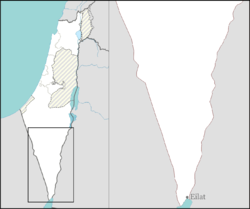Ezuz
Ezuz
| |
|---|---|
 | |
| Coordinates: 30°47′30.35″N 34°28′21.08″E / 30.7917639°N 34.4725222°E | |
| Country | Israel |
| District | Southern |
| Council | Ramat Negev |
| Founded | 1985 |
| Population (2022)[1] | 86 |
Ezuz (Template:Lang-he-n) is a small community settlement in the Negev desert, Israel. Named for Nahal Ezuz, a dry riverbed, it is located south of Nitzana. Ezuz is under the jurisdiction of the Ramat HaNegev Regional Council. In 2022 it had a population of 86.[1]
History
Ezuz was established in 1985 on the site of a kibbutz outpost abandoned after Six-Day War.[2] The major sources of income are traditional agriculture, tourism and art.
Ezuz is the site of a traditionally inspired farm project which uses ancient Nabataean floodwater capture techniques to raise a variety of fruits and vegetables with minimal external irrigation and no artificial fertilisation or pesticide. Residents of the village also raise livestock for local use, and produce goat cheese and organic olive oil.[3]
Tourism is an upcoming source of income. Most families provide bed and breakfast, there is a cafe, possibilities of (guided) camel or jeep tours and a hiking and biking route. Some residents are full or part-time artists.
Archaeology
Two ancient wells, the Moshe Well and Aharon Well, were discovered under the settlement. Therefore the name of the place is also "Two Wells": in Hebrew: "Be'erotayim" and in Arabic: "Biriin". Today there is a small biblical park "Be'erotayim" around the 2 wells. Some connect it to the wells "be'erot" of Deuteronomy 10:6. Ezuz is not far from the historical, biblical Kadesh-Barnea (Deuteronomy 9:23) on the Egyptian side of the border. The Beerotayim area was partially surveyed by R.Cohen of the Israel Antiquities Authority in 1985. The Iron Age and Persian fortresses were excavated by Cohen in 1986.[4]
References
- ^ a b "Regional Statistics". Israel Central Bureau of Statistics. Retrieved 21 March 2024.
- ^ Carta's Official Guide to Israel and Complete Gazetteer to all Sites in the Holy Land. (3rd edition 1993) Jerusalem, Carta, p.156, ISBN 965-220-186-3 (English)
- ^ Little House in the Desert, Haaretz
- ^ Negev, Avraham/Gibson, Shimon: Archaeological Encyclopedia of the Holy Land, Continuum P.H., p.72, London/New York 2005, ISBN 978-0-8264-8571-7

